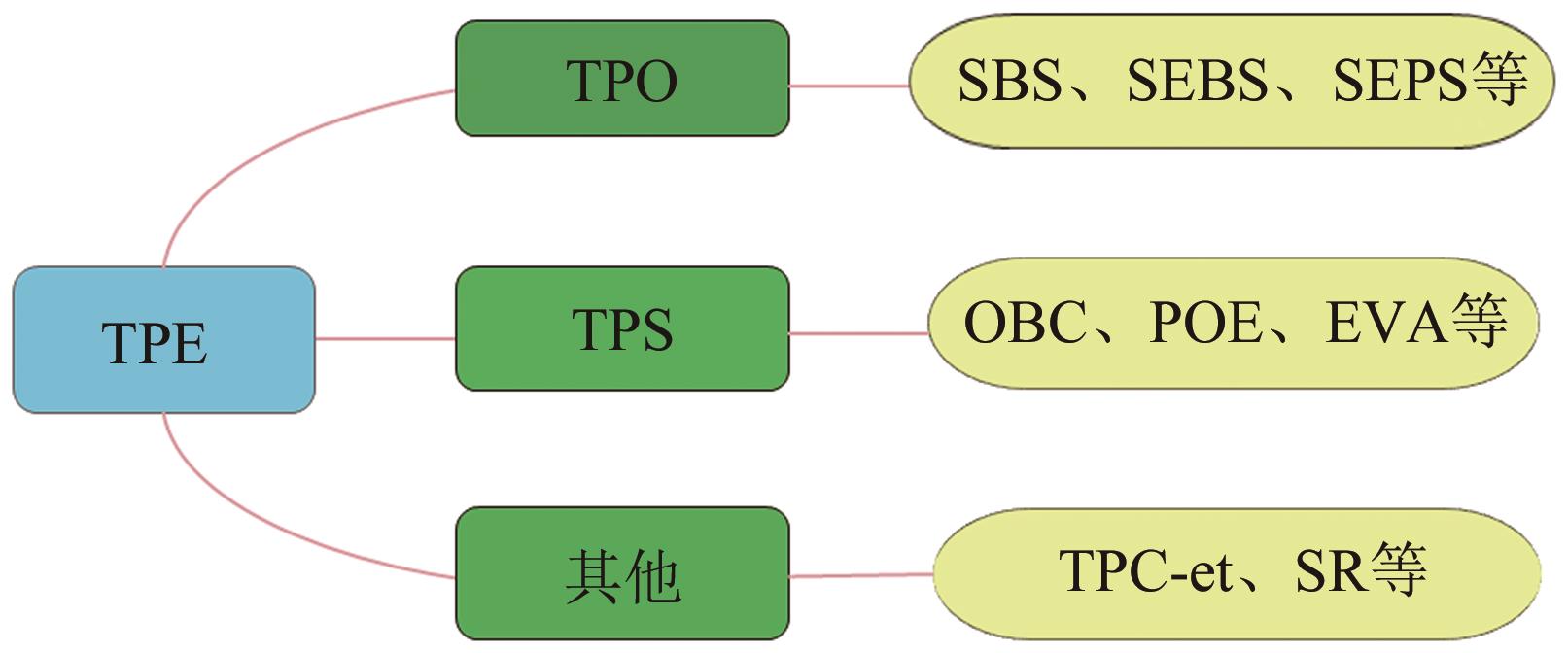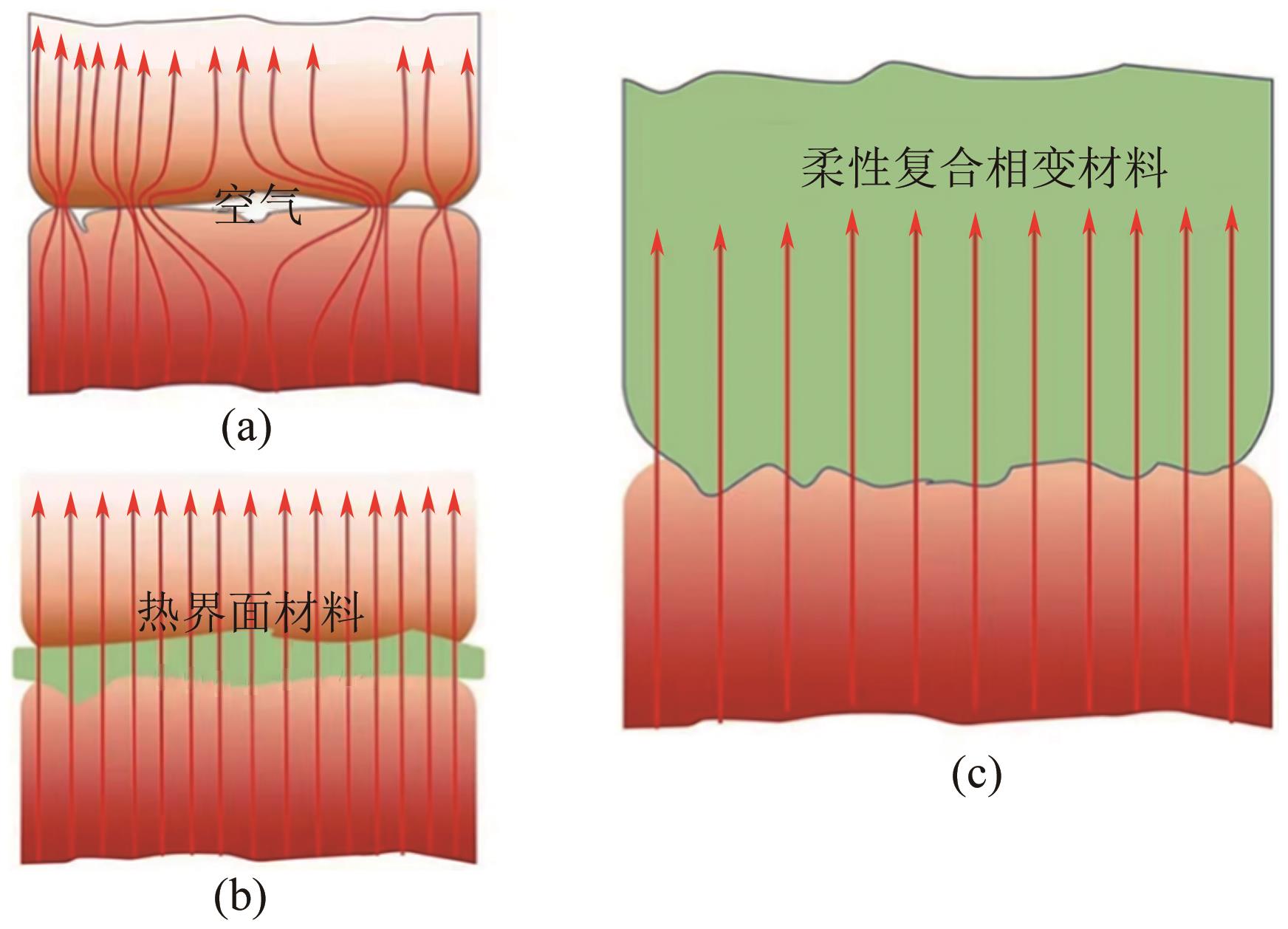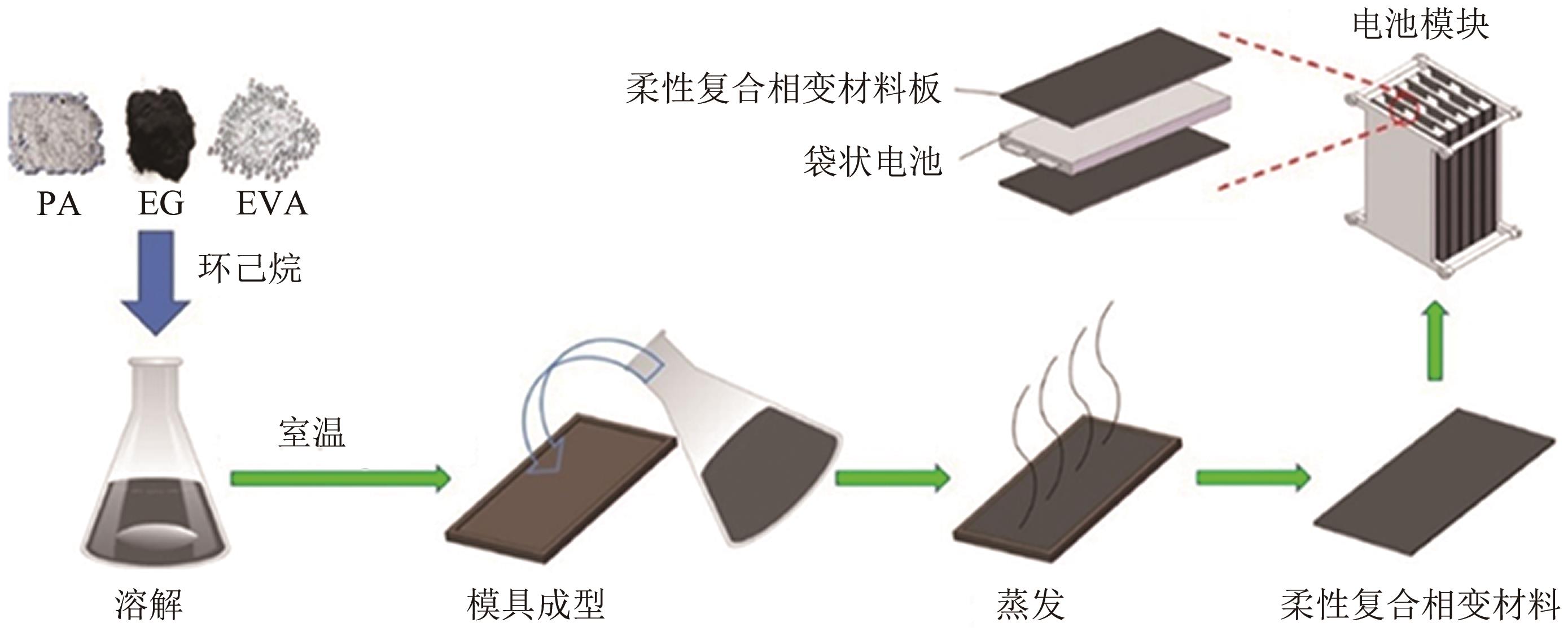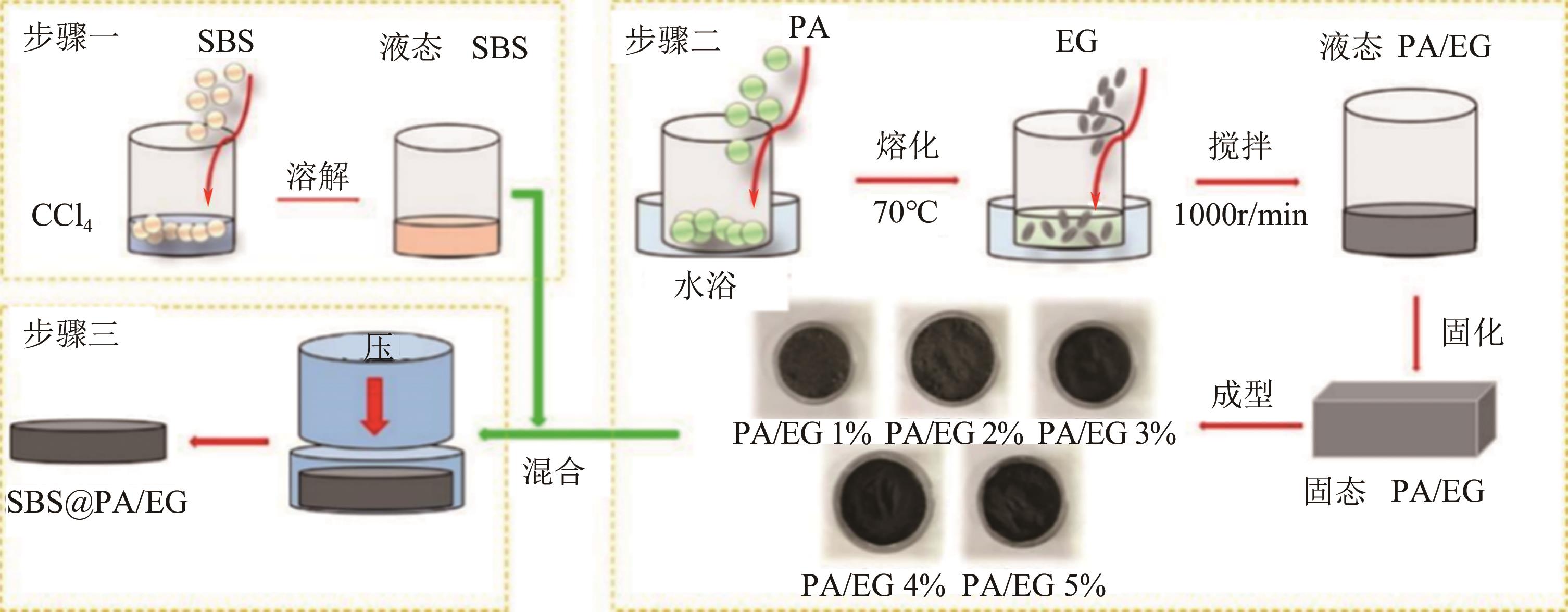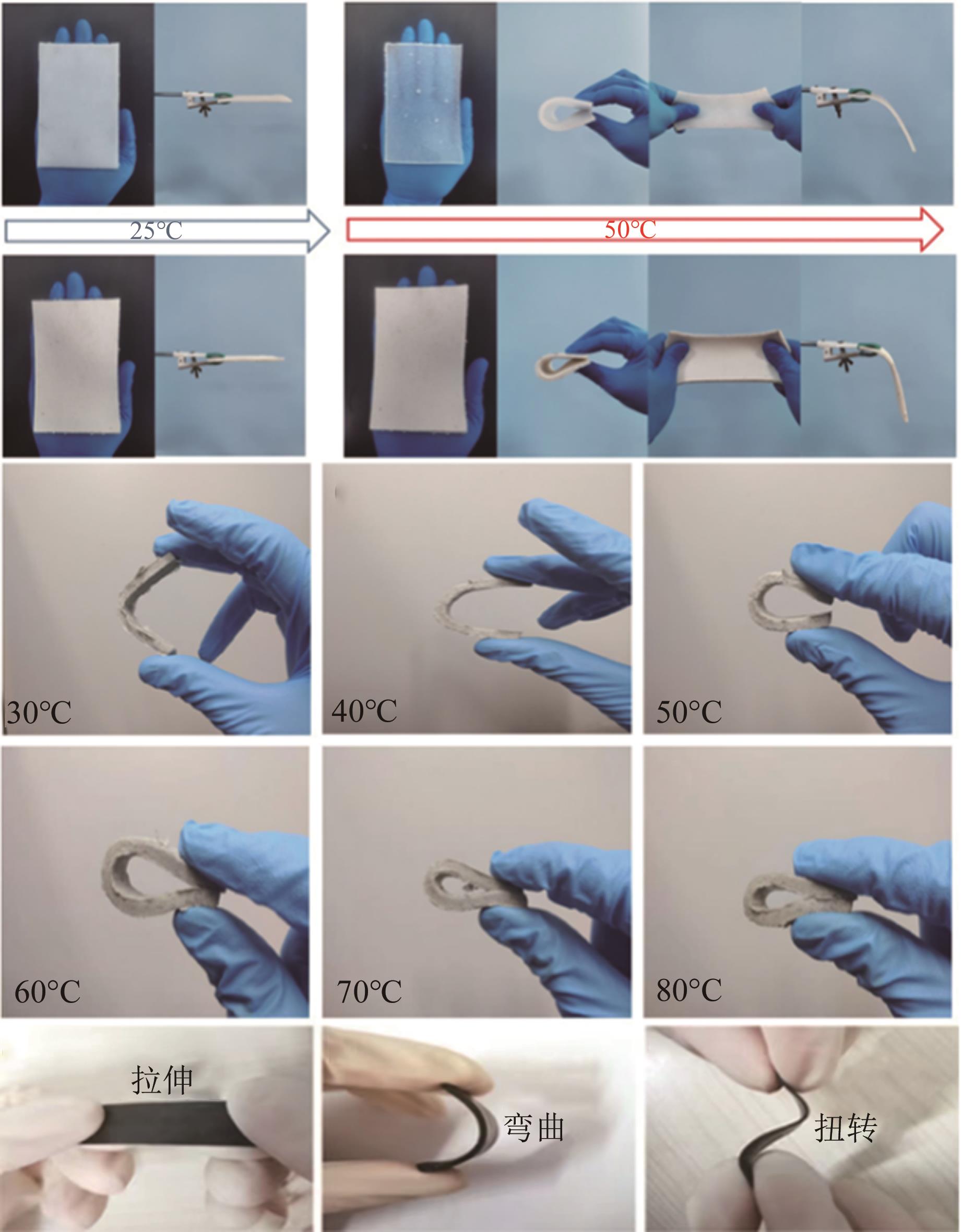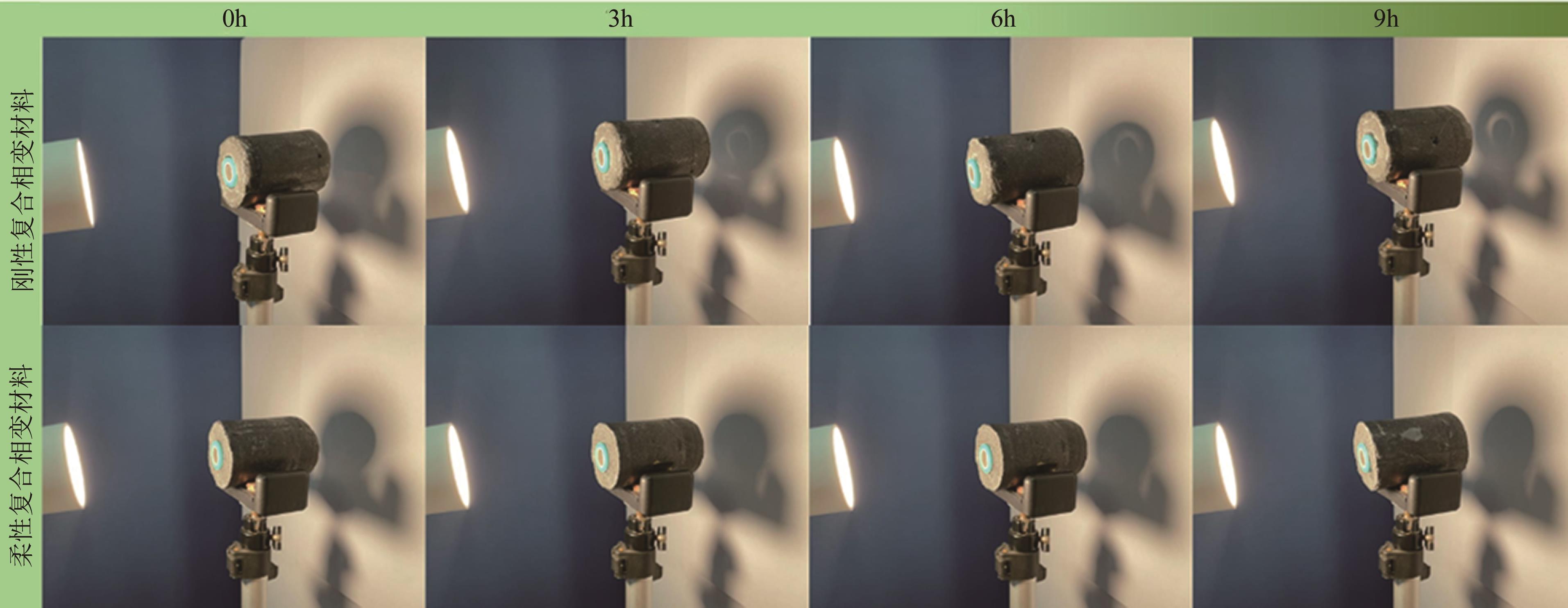Chemical Industry and Engineering Progress ›› 2024, Vol. 43 ›› Issue (6): 3159-3173.DOI: 10.16085/j.issn.1000-6613.2023-0855
• Materials science and technology • Previous Articles
Research progress of TPE-based flexible composite phase change materials for thermal management of lithium batteries
HE Ruiqiang1( ), FANG Min1(
), FANG Min1( ), ZHOU Jianduo1, FEI Hua1, YANG Kai2
), ZHOU Jianduo1, FEI Hua1, YANG Kai2
- 1.School of Civil Engineering and Surveying and Mapping Engineering, Jiangxi University of Science and Technology, Ganzhou 341000, Jiangxi, China
2.School of Chemistry and Chemical Engineering, Jiangxi University of Science and Technology, Ganzhou 341000, Jiangxi, China
-
Received:2023-05-24Revised:2023-07-02Online:2024-07-02Published:2024-06-15 -
Contact:FANG Min
锂电池热管理用TPE基柔性复合相变材料的研究进展
- 1.江西理工大学土木与测绘工程学院,江西 赣州 341000
2.江西理工大学材料冶金化学学部,江西 赣州 341000
-
通讯作者:方敏 -
作者简介:何瑞强(1997—),男,硕士研究生,研究方向为定型复合相变储能材料。E-mail:herq0809@163.com。 -
基金资助:国家自然科学基金面上项目(51966004);江西省自然科学基金(20192BAB216030);江西省教育厅青年项目(GJJ180498)
CLC Number:
Cite this article
HE Ruiqiang, FANG Min, ZHOU Jianduo, FEI Hua, YANG Kai. Research progress of TPE-based flexible composite phase change materials for thermal management of lithium batteries[J]. Chemical Industry and Engineering Progress, 2024, 43(6): 3159-3173.
何瑞强, 方敏, 周健夺, 费华, 杨凯. 锂电池热管理用TPE基柔性复合相变材料的研究进展[J]. 化工进展, 2024, 43(6): 3159-3173.
share this article
Add to citation manager EndNote|Ris|BibTeX
URL: https://hgjz.cip.com.cn/EN/10.16085/j.issn.1000-6613.2023-0855
| 材料类型 | 种类 | 价格/CNY·kg-1 | 途径 |
|---|---|---|---|
| TPE | SEBS(美国科腾G1654) | 14.8 | 东莞市晟华塑胶原料有限公司 |
| SEPS(YH-4051) | 23 | 岳阳市巴陵佳云石化有限公司 | |
| SBS | 11 | 惠州市惠州LCY弹性体有限公司 | |
| EVA(美国杜邦EVA 660) | 20 | 东莞市英翔塑胶原料有限公司 | |
| POE(A4090S) | 13.8 | 东莞市缘信塑胶原料有限公司 | |
| OBC(陶氏9530) | 18.8 | 深圳市万塑源橡塑有限公司 | |
| SR(HY系列) | 58 | 深圳红叶硅胶股份科技有限公司 | |
| TPC-et(Hytrel 30HS) | 35 | 东莞市塑佳高分子原料有限公司 | |
| TPE(陶氏杜邦4000-60A) | 20 | 苏州腾旺国际贸易有限公司 | |
| PCM | 切片石蜡(690189610) | 70 | 国药集团化学试剂有限公司 |
| 石蜡 | 45 | 上海焦耳蜡业有限公司 |
| 材料类型 | 种类 | 价格/CNY·kg-1 | 途径 |
|---|---|---|---|
| TPE | SEBS(美国科腾G1654) | 14.8 | 东莞市晟华塑胶原料有限公司 |
| SEPS(YH-4051) | 23 | 岳阳市巴陵佳云石化有限公司 | |
| SBS | 11 | 惠州市惠州LCY弹性体有限公司 | |
| EVA(美国杜邦EVA 660) | 20 | 东莞市英翔塑胶原料有限公司 | |
| POE(A4090S) | 13.8 | 东莞市缘信塑胶原料有限公司 | |
| OBC(陶氏9530) | 18.8 | 深圳市万塑源橡塑有限公司 | |
| SR(HY系列) | 58 | 深圳红叶硅胶股份科技有限公司 | |
| TPC-et(Hytrel 30HS) | 35 | 东莞市塑佳高分子原料有限公司 | |
| TPE(陶氏杜邦4000-60A) | 20 | 苏州腾旺国际贸易有限公司 | |
| PCM | 切片石蜡(690189610) | 70 | 国药集团化学试剂有限公司 |
| 石蜡 | 45 | 上海焦耳蜡业有限公司 |
| 柔性载体 | CPCM | 质量分数比/% | 熔点/℃ | 潜热/kJ·kg-1 | 热导率/W·m-1·K-1 | 参考文献 |
|---|---|---|---|---|---|---|
| SEBS | PA/h-BN/SEBS | 60/20/20 | 41.1 | 127.8 | 2.7 | [ |
| SEBS | PA/EG/SEBS | 76.2/4.8/19 | 47.35 | 159.2 | 1.226 | [ |
| SEPS | PA/EG/SEPS | (85.5/81/72/63)/ (5/10/20/30)/ (9.5/9/8/7) | 48/49.1/50.2/53.1 | 211.9~155.4 | 2.671/4.495/7.475/10.019 | [ |
| SEPS | PA/EG/SEPS | 81/4/15 | 42.5 | 202.78 | 1.581 | [ |
| SBS | PA/CNT/SBS | 85/2/13 | 61.56 | 147.63 | 0.39 | [ |
| PA/SBS | 85/15 | 64.14 | 140.74 | 0.3 | ||
| PA | 61.55 | 200.01 | 0.28 | |||
| SBS | PA/AlN/SBS | 35/15/50 | 46.82 | 57.06 | 0.5 | [ |
| SBS | PA/EG/SBS | 46/5/50 | 47.7 | 79.8 | 0.87 | [ |
| TPS(SBS/SEBS) | PA/EG/TPS | 50/7/43 | 44 | 1.271 | [ |
| 柔性载体 | CPCM | 质量分数比/% | 熔点/℃ | 潜热/kJ·kg-1 | 热导率/W·m-1·K-1 | 参考文献 |
|---|---|---|---|---|---|---|
| SEBS | PA/h-BN/SEBS | 60/20/20 | 41.1 | 127.8 | 2.7 | [ |
| SEBS | PA/EG/SEBS | 76.2/4.8/19 | 47.35 | 159.2 | 1.226 | [ |
| SEPS | PA/EG/SEPS | (85.5/81/72/63)/ (5/10/20/30)/ (9.5/9/8/7) | 48/49.1/50.2/53.1 | 211.9~155.4 | 2.671/4.495/7.475/10.019 | [ |
| SEPS | PA/EG/SEPS | 81/4/15 | 42.5 | 202.78 | 1.581 | [ |
| SBS | PA/CNT/SBS | 85/2/13 | 61.56 | 147.63 | 0.39 | [ |
| PA/SBS | 85/15 | 64.14 | 140.74 | 0.3 | ||
| PA | 61.55 | 200.01 | 0.28 | |||
| SBS | PA/AlN/SBS | 35/15/50 | 46.82 | 57.06 | 0.5 | [ |
| SBS | PA/EG/SBS | 46/5/50 | 47.7 | 79.8 | 0.87 | [ |
| TPS(SBS/SEBS) | PA/EG/TPS | 50/7/43 | 44 | 1.271 | [ |
| 柔性载体 | CPCM | 质量分数比/% | 熔点/℃ | 潜热/kJ·kg-1 | 热导率/W·m-1·K-1 | 参考文献 |
|---|---|---|---|---|---|---|
| EVA | PA/EG/EVA | (50/49.5/48.5/47.5)/ (0/1/3/5)/ (50/49.5/48.5/47.5) | 53 | 141/129/123/121 | 0.3/0.4/0.9/1.7 | [ |
| EVA | PA/EG/EVA-g-MAH/MA/TPP | 60/3.5/11.5/10/15 | 47.5 | 125.7 | 1.39 | [ |
| POE | PA/EG/POE | (27/36/45/54/63)/ (3/4/5/6/7)/ (70/60/50/40/30) | 65.4/63/64.2/65.3 /65.6 | 51.5/67.1/90.5/108.5/126.7 | 0.62/0.78/0.96/1.41/1.43 | [ |
| OBC | PA/EG/OBC | 45/10/45 | 约51 | 101 | 1.57 | [ |
| OBC | PA/OBC/EG/AlN | 57/20/3/20 | 44.1 | 145.26 | 1.564 | [ |
| OBC | PA/EG/OBC | (79.2/76/72)/ (1/5/10)/ (19.8/19/18) | 50.73/49.67/47.42 | 197.7/185.4 /176.7 | 0.62/2.34/5.5 | [ |
| OBC | PA/EG/OBC | 72/10/18 | 42.3 | 130 | 3 | [ |
| 柔性载体 | CPCM | 质量分数比/% | 熔点/℃ | 潜热/kJ·kg-1 | 热导率/W·m-1·K-1 | 参考文献 |
|---|---|---|---|---|---|---|
| EVA | PA/EG/EVA | (50/49.5/48.5/47.5)/ (0/1/3/5)/ (50/49.5/48.5/47.5) | 53 | 141/129/123/121 | 0.3/0.4/0.9/1.7 | [ |
| EVA | PA/EG/EVA-g-MAH/MA/TPP | 60/3.5/11.5/10/15 | 47.5 | 125.7 | 1.39 | [ |
| POE | PA/EG/POE | (27/36/45/54/63)/ (3/4/5/6/7)/ (70/60/50/40/30) | 65.4/63/64.2/65.3 /65.6 | 51.5/67.1/90.5/108.5/126.7 | 0.62/0.78/0.96/1.41/1.43 | [ |
| OBC | PA/EG/OBC | 45/10/45 | 约51 | 101 | 1.57 | [ |
| OBC | PA/OBC/EG/AlN | 57/20/3/20 | 44.1 | 145.26 | 1.564 | [ |
| OBC | PA/EG/OBC | (79.2/76/72)/ (1/5/10)/ (19.8/19/18) | 50.73/49.67/47.42 | 197.7/185.4 /176.7 | 0.62/2.34/5.5 | [ |
| OBC | PA/EG/OBC | 72/10/18 | 42.3 | 130 | 3 | [ |
| 柔性载体 | CPCM | 质量分数比/% | 熔点/℃ | 潜热/kJ·kg-1 | 热导率/W·m-1·K-1 | 参考文献 |
|---|---|---|---|---|---|---|
| SR | PA/BN/EG/SR | 30/5.6/3.4/61 | 47.3 | 62.7 | 0.95 | [ |
| TPC-et | PA/EG/TPC-et | 45/10/45 | 102 | 1.64 | [ | |
| TPE | PA/EG/TPE | (27/36/45/54/63)/(3/4/5/6/7)/ (70/60/50/40/30) | 50.4/53/53.8/57.8/59 | 62.3/83.1/103.5/124.6/145.4 | 0.6/0.9/1.4/1.8/2.2 | [ |
| TPEE | PA/EG/TPEE | (59.4/58.2/57)/(1/3/5)/(39.6/38.8/38) | 47.4/46.5/46.4 | 111.2/113.2/112.5 | 0.248/0.502/1.267 | [ |
| 柔性载体 | CPCM | 质量分数比/% | 熔点/℃ | 潜热/kJ·kg-1 | 热导率/W·m-1·K-1 | 参考文献 |
|---|---|---|---|---|---|---|
| SR | PA/BN/EG/SR | 30/5.6/3.4/61 | 47.3 | 62.7 | 0.95 | [ |
| TPC-et | PA/EG/TPC-et | 45/10/45 | 102 | 1.64 | [ | |
| TPE | PA/EG/TPE | (27/36/45/54/63)/(3/4/5/6/7)/ (70/60/50/40/30) | 50.4/53/53.8/57.8/59 | 62.3/83.1/103.5/124.6/145.4 | 0.6/0.9/1.4/1.8/2.2 | [ |
| TPEE | PA/EG/TPEE | (59.4/58.2/57)/(1/3/5)/(39.6/38.8/38) | 47.4/46.5/46.4 | 111.2/113.2/112.5 | 0.248/0.502/1.267 | [ |
| 柔性载体 | CPCM | 质量分数比/% | 环境温度/℃ | 放电倍率 | 最高温度/℃ | 最大温差/℃ | 参考文献 |
|---|---|---|---|---|---|---|---|
| SEBS | PA/h-BN/SEBS | 60/20/20 | 25 | 1C/2C/3C | 35/40/47 | 1.1/1.2/2.1 | [ |
| NC | — | 25 | 1C/2C/3C | 43/58/76.1 | 4.3/5.4/6.7 | ||
| SEBS | PA/EG/SEBS | 76.2/4.8/19 | 30 | 1C/2C/3C | 35.8/39.4/42.2 | 1.6/2.5/3.3 | [ |
| SEPS | PA/EG/SEPS | 85.5/5/9.5 | — | 2C/3C | 38.6/43.2 | 0.7/1.5 | [ |
| PA/EG/SEPS | 72/20/8 | — | 2C/3C | 38.1/42.2 | 0.4/1.0 | ||
| SEPS | PA/EG/SEPS | 82/3/15 | — | 1C/2C/3C | 33.73/38.46/42.96 | 0.2/0.5/0.6 | [ |
| PA/SEPS | 90/10 | — | 1C/2C/3C | 35.13/40.65/47.35 | 0.4/0.78/1.2 | ||
| 无PCM | — | — | 1C/2C/3C | 35.15/41.49/51.01 | 0.79/1.68/3.1 | ||
| SBS | PA/AlN/SBS | 35/15/50 | — | 1C/2C/3C | 32.5/34/42.5 | 0.9/2/8.9 | [ |
| TPS(SBS/SEBS) | PA/EG/TPS | 50/7/43 | 26 | 1C/2C/2.5C | 30.5/33.9/36.2 | 2.9/3.7/4.0 | [ |
| NC | — | 26 | 1C/2C/2.5C | 36.4/42.6/47.9 | 4.9/5.7/7.5 |
| 柔性载体 | CPCM | 质量分数比/% | 环境温度/℃ | 放电倍率 | 最高温度/℃ | 最大温差/℃ | 参考文献 |
|---|---|---|---|---|---|---|---|
| SEBS | PA/h-BN/SEBS | 60/20/20 | 25 | 1C/2C/3C | 35/40/47 | 1.1/1.2/2.1 | [ |
| NC | — | 25 | 1C/2C/3C | 43/58/76.1 | 4.3/5.4/6.7 | ||
| SEBS | PA/EG/SEBS | 76.2/4.8/19 | 30 | 1C/2C/3C | 35.8/39.4/42.2 | 1.6/2.5/3.3 | [ |
| SEPS | PA/EG/SEPS | 85.5/5/9.5 | — | 2C/3C | 38.6/43.2 | 0.7/1.5 | [ |
| PA/EG/SEPS | 72/20/8 | — | 2C/3C | 38.1/42.2 | 0.4/1.0 | ||
| SEPS | PA/EG/SEPS | 82/3/15 | — | 1C/2C/3C | 33.73/38.46/42.96 | 0.2/0.5/0.6 | [ |
| PA/SEPS | 90/10 | — | 1C/2C/3C | 35.13/40.65/47.35 | 0.4/0.78/1.2 | ||
| 无PCM | — | — | 1C/2C/3C | 35.15/41.49/51.01 | 0.79/1.68/3.1 | ||
| SBS | PA/AlN/SBS | 35/15/50 | — | 1C/2C/3C | 32.5/34/42.5 | 0.9/2/8.9 | [ |
| TPS(SBS/SEBS) | PA/EG/TPS | 50/7/43 | 26 | 1C/2C/2.5C | 30.5/33.9/36.2 | 2.9/3.7/4.0 | [ |
| NC | — | 26 | 1C/2C/2.5C | 36.4/42.6/47.9 | 4.9/5.7/7.5 |
| 柔性载体 | CPCM | 质量分数比/% | 环境温度/℃ | 放电倍率 | 最高温度/℃ | 最大温差/℃ | 参考文献 |
|---|---|---|---|---|---|---|---|
| EVA | PA/EG/EVA | 47.5/5/47.5 | 30 | 1C/2C/3C/4C | 38/44.3/50/50.3 | 2.8/3.9/4.1/4.5 | [ |
| PA/EG/LDPE | 47.5/5/47.5 | 30 | 1C/2C/3C/4C | 40.1/46.3/48/55.8 | 3.5/4.4/4.8/6.1 | ||
| EVA | PA/EG/EVA-g-MAH/MA/TPP | 60/3.5/11.5/10/15 | 25 | 1C/2C/3C | 34.3/42.5/44.3 | 1.7/2.6/3 | [ |
| OBC | PA/EG/OBC | 76/5/19 | — | 1C/2C/2.5C | 34/42/44 | — | [ |
| 柔性载体 | CPCM | 质量分数比/% | 环境温度/℃ | 放电倍率 | 最高温度/℃ | 最大温差/℃ | 参考文献 |
|---|---|---|---|---|---|---|---|
| EVA | PA/EG/EVA | 47.5/5/47.5 | 30 | 1C/2C/3C/4C | 38/44.3/50/50.3 | 2.8/3.9/4.1/4.5 | [ |
| PA/EG/LDPE | 47.5/5/47.5 | 30 | 1C/2C/3C/4C | 40.1/46.3/48/55.8 | 3.5/4.4/4.8/6.1 | ||
| EVA | PA/EG/EVA-g-MAH/MA/TPP | 60/3.5/11.5/10/15 | 25 | 1C/2C/3C | 34.3/42.5/44.3 | 1.7/2.6/3 | [ |
| OBC | PA/EG/OBC | 76/5/19 | — | 1C/2C/2.5C | 34/42/44 | — | [ |
| 柔性载体 | CPCM | 质量分数比/% | 环境温度/℃ | 放电倍率 | 最高温度/℃ | 最大温差/℃ | 参考文献 |
|---|---|---|---|---|---|---|---|
| TPC-et | PA/EG/TPC-et | 45/10/45 | 30 | 1C/2C/3C | 33.5/37.2/41.1 | — | [ |
| NC | — | 30 | 1C/2C/3C | 34.8/41.6/44.6 | — | ||
| TPEE | PA/EG/TPEE | 57/5/38 | 25 | 1C/3C/5C | 32.6/42.3/49.9 | 0.95/1.39/1.95 | [ |
| NC | — | — | 1C/3C/5C | 38.1/63.7/82.2 | — | ||
| SR | PA/BN/EG/SR | 61.1/5.6/3.3/30 | 25 | 3C/4C | 45.7/53.4 | 1.9/3.7 | [ |
| NC | — | 25 | 3C/4C | 60.3/74.3 | 3.3/9.1 |
| 柔性载体 | CPCM | 质量分数比/% | 环境温度/℃ | 放电倍率 | 最高温度/℃ | 最大温差/℃ | 参考文献 |
|---|---|---|---|---|---|---|---|
| TPC-et | PA/EG/TPC-et | 45/10/45 | 30 | 1C/2C/3C | 33.5/37.2/41.1 | — | [ |
| NC | — | 30 | 1C/2C/3C | 34.8/41.6/44.6 | — | ||
| TPEE | PA/EG/TPEE | 57/5/38 | 25 | 1C/3C/5C | 32.6/42.3/49.9 | 0.95/1.39/1.95 | [ |
| NC | — | — | 1C/3C/5C | 38.1/63.7/82.2 | — | ||
| SR | PA/BN/EG/SR | 61.1/5.6/3.3/30 | 25 | 3C/4C | 45.7/53.4 | 1.9/3.7 | [ |
| NC | — | 25 | 3C/4C | 60.3/74.3 | 3.3/9.1 |
| 柔性载体 | CPCM | 质量分数比 /% | 抗压强度 /MPa | 抗拉强度 /MPa | 抗弯强度 /MPa | 最大应力 /MPa | 断裂伸长率 /% | 参考文献 |
|---|---|---|---|---|---|---|---|---|
| SEBS | PA/h-BN/SEBS | 60/20/20 | — | 0.72 | — | — | — | [ |
| SBS | PA/CNT/SBS | (80/85/90)/2/(18/13/8) | — | 0.5~0.75 | — | /1.47/1.78 | 13.79/20.33/2.58 | [ |
| SBS | PA/AlN/SBS | 50/15/35 | — | 0.19 | 0.6 | — | — | [ |
| EVA | PA/EG/EVA | 47.5/5/47.5 | 8.07 | 0.83 | 0.02 | — | 3.68 | [ |
| PA/EG/LDPE | 47.5/5/47.5 | 143.45 | 81.2 | 2.45 | — | 1.98 | ||
| OBC | PA/EG/OBC | 45/10/45 | 34.36 | 5.44 | 1.21 | — | 3.62 | [ |
| SR | PA/BN/EG/SR | 61.1/5.6/3.4/30 | 0.7 | — | — | — | — | [ |
| PW/EG/SR | 0.46 | — | — | — | — | |||
| TPC-et | PA/EG/TPC-et | 45/10/45 | 5.02 | 0.88 | 0.14 | — | 5.24 | [ |
| TPS(SBS/SEBS) | PA/EG/TPS | 50/7/43 | — | 0.408 | — | — | 41.257 | [ |
| TPEE | PA/EG/TPEE | (59.4/58.2/57)/(1/3/5)/(39.6/38.8/38) | — | 4.9/4.6/4.5 | — | — | — | [ |
| 柔性载体 | CPCM | 质量分数比 /% | 抗压强度 /MPa | 抗拉强度 /MPa | 抗弯强度 /MPa | 最大应力 /MPa | 断裂伸长率 /% | 参考文献 |
|---|---|---|---|---|---|---|---|---|
| SEBS | PA/h-BN/SEBS | 60/20/20 | — | 0.72 | — | — | — | [ |
| SBS | PA/CNT/SBS | (80/85/90)/2/(18/13/8) | — | 0.5~0.75 | — | /1.47/1.78 | 13.79/20.33/2.58 | [ |
| SBS | PA/AlN/SBS | 50/15/35 | — | 0.19 | 0.6 | — | — | [ |
| EVA | PA/EG/EVA | 47.5/5/47.5 | 8.07 | 0.83 | 0.02 | — | 3.68 | [ |
| PA/EG/LDPE | 47.5/5/47.5 | 143.45 | 81.2 | 2.45 | — | 1.98 | ||
| OBC | PA/EG/OBC | 45/10/45 | 34.36 | 5.44 | 1.21 | — | 3.62 | [ |
| SR | PA/BN/EG/SR | 61.1/5.6/3.4/30 | 0.7 | — | — | — | — | [ |
| PW/EG/SR | 0.46 | — | — | — | — | |||
| TPC-et | PA/EG/TPC-et | 45/10/45 | 5.02 | 0.88 | 0.14 | — | 5.24 | [ |
| TPS(SBS/SEBS) | PA/EG/TPS | 50/7/43 | — | 0.408 | — | — | 41.257 | [ |
| TPEE | PA/EG/TPEE | (59.4/58.2/57)/(1/3/5)/(39.6/38.8/38) | — | 4.9/4.6/4.5 | — | — | — | [ |
| 1 | HUA Yang, ZHOU Sida, HUANG Yi, et al. Sustainable value chain of retired lithium-ion batteries for electric vehicles[J]. Journal of Power Sources, 2020, 478: 228753. |
| 2 | CHITTA Sandeep Dattu, AKKALDEVI Chaithanya, JAIDI Jeevan, et al. Comparison of lumped and 1D electrochemical models for prismatic 20Ah LiFePO4 battery sandwiched between minichannel cold-plates[J]. Applied Thermal Engineering, 2021, 199: 117586. |
| 3 | Antti VÄYRYNEN, SALMINEN Justin. Lithium ion battery production[J]. The Journal of Chemical Thermodynamics, 2012, 46: 80-85. |
| 4 | AMJAD Muhammad, AHMAD Ayaz, REHMANI Mubashir Husain, et al. A review of EVs charging: From the perspective of energy optimization, optimization approaches, and charging techniques[J]. Transportation Research Part D: Transport and Environment, 2018, 62: 386-417. |
| 5 | YANG Ruixin, XIONG Rui, SHEN Weixiang, et al. Extreme learning machine-based thermal model for lithium-ion batteries of electric vehicles under external short circuit[J]. Engineering, 2021, 7(3): 395-405. |
| 6 | KSHETRIMAYUM Krishnadash S, YOON Young-Gak, Hye-Ri GYE, et al. Preventing heat propagation and thermal runaway in electric vehicle battery modules using integrated PCM and micro-channel plate cooling system[J]. Applied Thermal Engineering, 2019, 159: 113797. |
| 7 | WU Weixiong, WU Wei, WANG Shuangfeng. Thermal optimization of composite PCM based large-format lithium-ion battery modules under extreme operating conditions[J]. Energy Conversion and Management, 2017, 153: 22-33. |
| 8 | TIARI Saeed, MAHDAVI Mahboobe, QIU Songgang. Experimental study of a latent heat thermal energy storage system assisted by a heat pipe network[J]. Energy Conversion and Management, 2017, 153: 362-373. |
| 9 | NA Xiaoyu, KANG Huifang, WANG Teng, et al. Reverse layered air flow for Li-ion battery thermal management[J]. Applied Thermal Engineering, 2018, 143: 257-262. |
| 10 | TANG Zhiguo, LIU Zhiqing, LI Jie, et al. A lightweight liquid cooling thermal management structure for prismatic batteries[J]. Journal of Energy Storage, 2021, 42: 103078. |
| 11 | CHOUDHARI V G, DHOBLE A S, PANCHAL Satyam, et al. Numerical investigation on thermal behaviour of 5 × 5 cell configured battery pack using phase change material and fin structure layout[J]. Journal of Energy Storage, 2021, 43: 103234. |
| 12 | WENG Jingwen, HE Yaping, OUYANG Dongxu, et al. Thermal performance of PCM and branch-structured fins for cylindrical power battery in a high-temperature environment[J]. Energy Conversion and Management, 2019, 200: 112106. |
| 13 | PING Ping, PENG Rongqi, KONG Depeng, et al. Investigation on thermal management performance of PCM-fin structure for Li-ion battery module in high-temperature environment[J]. Energy Conversion and Management, 2018, 176: 131-146. |
| 14 | LI Yantong, DU Yaxing, XU Tao, et al. Optimization of thermal management system for Li-ion batteries using phase change material[J]. Applied Thermal Engineering, 2018, 131: 766-778. |
| 15 | GRECO Angelo, JIANG Xi, CAO Dongpu. An investigation of lithium-ion battery thermal management using paraffin/porous-graphite-matrix composite[J]. Journal of Power Sources, 2015, 278: 50-68. |
| 16 | HUSSAIN Abid, ABIDI Irfan H, TSO C Y, et al. Thermal management of lithium ion batteries using graphene coated nickel foam saturated with phase change materials[J]. International Journal of Thermal Sciences, 2018, 124: 23-35. |
| 17 | LUO Dajun, XIANG Li, SUN Xin, et al. Phase-change smart lines based on paraffin-expanded graphite/polypropylene hollow fiber membrane composite phase change materials for heat storage[J]. Energy, 2020, 197: 117252. |
| 18 | SAMIMI Fereshteh, BABAPOOR Aziz, AZIZI Mohammadmehdi, et al. Thermal management analysis of a Li-ion battery cell using phase change material loaded with carbon fibers[J]. Energy, 2016, 96: 355-371. |
| 19 | BABAPOOR A, AZIZI M, KARIMI G. Thermal management of a Li-ion battery using carbon fiber-PCM composites[J]. Applied Thermal Engineering, 2015, 82: 281-290. |
| 20 | MISHRA A K, LAHIRI B B, PHILIP J. Carbon black nano particle loaded lauric acid-based form-stable phase change material with enhanced thermal conductivity and photo-thermal conversion for thermal energy storage[J]. Energy, 2020, 191: 116572. |
| 21 | BABAPOOR Aziz, KARIMI Gholamreza, SABBAGHI Samad. Thermal characteristic of nanocomposite phase change materials during solidification process[J]. Journal of Energy Storage, 2016, 7: 74-81. |
| 22 | NOËL John A, WHITE Mary Anne. Freeze-cast form-stable phase change materials for thermal energy storage[J]. Solar Energy Materials and Solar Cells, 2021, 223: 110956. |
| 23 | Youfu LYU, LIU Guangjun, ZHANG Guoqing, et al. A novel thermal management structure using serpentine phase change material coupled with forced air convection for cylindrical battery modules[J]. Journal of Power Sources, 2020, 468: 228398. |
| 24 | MU Mulan, BASHEER P A M, SHA Wei, et al. Shape stabilised phase change materials based on a high melt viscosity HDPE and paraffin waxes[J]. Applied Energy, 2016, 162: 68-82. |
| 25 | MAO Dasha, CHEN Jiahui, REN Linlin, et al. Spherical core-shell Al@Al2O3 filled epoxy resin composites as high-performance thermal interface materials[J]. Composites A: Applied Science and Manufacturing, 2019, 123: 260-269. |
| 26 | KRUPA I, MIKOVÁ G, LUYT A S. Polypropylene as a potential matrix for the creation of shape stabilized phase change materials[J]. European Polymer Journal, 2007, 43(3): 895-907. |
| 27 | HUANG Qiqiu, LI Xinxi, ZHANG Guoqing, et al. Experimental investigation of the thermal performance of heat pipe assisted phase change material for battery thermal management system[J]. Applied Thermal Engineering, 2018, 141: 1092-1100. |
| 28 | JIANG Z Y, QU Z G. Lithium-ion battery thermal management using heat pipe and phase change material during discharge-charge cycle: A comprehensive numerical study[J]. Applied Energy, 2019, 242: 378-392. |
| 29 | WU Tingting, HU Yanxin, RONG Huiqiang, et al. SEBS-based composite phase change material with thermal shape memory for thermal management applications[J]. Energy, 2021, 221: 119900. |
| 30 | WU Weixiong, LIU Jizhen, LIU Min, et al. An innovative battery thermal management with thermally induced flexible phase change material[J]. Energy Conversion and Management, 2020, 221: 113145. |
| 31 | BRAND Martin J, SCHUSTER Simon F, BACH Tobias, et al. Effects of vibrations and shocks on lithium-ion cells[J]. Journal of Power Sources, 2015, 288: 62-69. |
| 32 | LILLEY Drew, LAU Jonathan, DAMES Chris, et al. Impact of size and thermal gradient on supercooling of phase change materials for thermal energy storage[J]. Applied Energy, 2021, 290: 116635. |
| 33 | JOSHY Naveen, HAJIYAN Mohammadhossein, SIDDIQUE Abu Raihan Mohammad, et al. Experimental investigation of the effect of vibration on phase change material (PCM) based battery thermal management system[J]. Journal of Power Sources, 2020, 450: 227717. |
| 34 | 崔小明. 我国丁苯热塑性弹性体的市场现状及发展前景[J]. 化学工业, 2011, 29(1): 15-17, 24. |
| CUI Xiaoming. Supply, demand status and development prospect of SBS in China[J]. Chemical Industry, 2011, 29(1): 15-17, 24. | |
| 35 | 贺小进, 王雪, 邱迎昕. SEEPS结构、性能及应用研究进展[J]. 石化技术, 2019, 26(11): 1-4. |
| HE Xiaojin, WANG Xue, QIU Yingxin. Advances on structure, properties and applications of SEEPS[J]. Petrochemical Industry Technology, 2019, 26(11): 1-4. | |
| 36 | 郭方飞, 闫邦锋, 崔志勇, 等. SEPS热塑性弹性体的催化专利进展[J]. 工业催化, 2016, 24(11): 6-9. |
| GUO Fangfei, YAN Bangfeng, CUI Zhiyong, et al. Catalytic patent progress in thermoplastic elastomer SEPS[J]. Industrial Catalysis, 2016, 24(11): 6-9. | |
| 37 | ZHANG Zishou, ZHAI Teng, LU Xihong, et al. Conductive membranes of EVA filled with carbon black and carbon nanotubes for flexible energy-storage devices[J]. Journal of Materials Chemistry A, 2013, 1(3): 505-509. |
| 38 | HEMANTH R, SURESHA B, SEKAR M. Effect of short glass fibre and fillers on friction and wear performance of multi-phased thermoplastic copolyester elastomer composites[J]. International Journal of Nanotechnology, 2017, 14(9/10/11): 893. |
| 39 | JI Tuo, ZHANG Liqun, WANG Wencai, et al. Cold plasma modification of boron nitride fillers and its effect on the thermal conductivity of silicone rubber/boron nitride composites[J]. Polymer Composites, 2012, 33(9): 1473-1481. |
| 40 | RAZEEB Kafil M, DALTON Eric, CROSS Graham Lawerence William, et al. Present and future thermal interface materials for electronic devices[J]. International Materials Reviews, 2018, 63(1): 1-21. |
| 41 | YANG Kaixin, LING Ziye, FANG Xiaoming, et al. Introducing a flexible insulation network to the expanded graphite-based composite phase change material to enhance dielectric and mechanical properties for battery thermal management[J]. Journal of Energy Storage, 2023, 66: 107486. |
| 42 | WENG Jingwen, HUANG Qiqiu, LI Xinxi, et al. Safety issue on PCM-based battery thermal management: Material thermal stability and system hazard mitigation[J]. Energy Storage Materials, 2022, 53: 580-612. |
| 43 | YANG Xiaoping, ZHANG Zhihao, CAI Zhuodi, et al. Experimental investigation on room-temperature flexible composite phase change materials in thermal management of power battery pack[J]. Applied Thermal Engineering, 2022, 213: 118748. |
| 44 | HUANG Qiqiu, LI Xinxi, ZHANG Guoqing, et al. Flexible composite phase change material with anti-leakage and anti-vibration properties for battery thermal management[J]. Applied Energy, 2022, 309: 118434. |
| 45 | LI Shaojun, DONG Xinlong, LIN Xiaodong, et al. Flexible phase change materials obtained from a simple solvent-evaporation method for battery thermal management[J]. Journal of Energy Storage, 2021, 44: 103447. |
| 46 | YANG Chong, CAI Zhijing, CHEN Hong, et al. Measurement and correlation of liquid-liquid equilibria for extracting isopropanol from cyclohexane with different solvents[J]. Journal of Chemical & Engineering Data, 2020, 65(1): 140-145. |
| 47 | HUANG Qiqiu, LI Xinxi, ZHANG Guoqing, et al. Thermal management of Lithium-ion battery pack through the application of flexible form-stable composite phase change materials[J]. Applied Thermal Engineering, 2021, 183: 116151. |
| 48 | UMAIR Malik Muhammad, ZHANG Yuang, IQBAL Kashif, et al. Novel strategies and supporting materials applied to shape-stabilize organic phase change materials for thermal energy storage-a review[J]. Applied Energy, 2019, 235: 846-873. |
| 49 | HU Die, HAN Liang, ZHOU Weiqing, et al. Flexible phase change composite based on loading paraffin into cross-linked CNT/SBS network for thermal management and thermal storage[J]. Chemical Engineering Journal, 2022, 437: 135056. |
| 50 | HUANG Qiqiu, DENG Jian, LI Xinxi, et al. Experimental investigation on thermally induced aluminum nitride based flexible composite phase change material for battery thermal management[J]. Journal of Energy Storage, 2020, 32: 101755. |
| 51 | RONG Huiqiang, WANG Changhong, LIU Xianqing, et al. A novel elastomeric copolymer-based phase change material with thermally induced flexible and shape-stable performance for prismatic battery module[J]. International Journal of Thermal Sciences, 2022, 174: 107435. |
| 52 | CAO Jiahao, LING Ziye, LIN Xuemin, et al. Flexible composite phase change material with enhanced thermophysical, dielectric, and mechanical properties for battery thermal management[J]. Journal of Energy Storage, 2022, 52: 104796. |
| 53 | LIN Xiangwei, ZHANG Xuelai, JI Jun, et al. Experimental investigation of form-stable phase change material with enhanced thermal conductivity and thermal-induced flexibility for thermal management[J]. Applied Thermal Engineering, 2022, 201: 117762. |
| 54 | LIN Xiangwei, ZHANG Xuelai, LIU Lu, et al. Polymer/expanded graphite-based flexible phase change material with high thermal conductivity for battery thermal management[J]. Journal of Cleaner Production, 2022, 331: 130014. |
| 55 | YANG Xiaoping, DENG Guolan, CAI Zhuodi, et al. Experimental study on novel composite phase change materials with room-temperature flexibility and high-temperature shape stability in a battery thermal management system[J]. International Journal of Heat and Mass Transfer, 2023, 206: 123953. |
| 56 | LI Yuming, WANG Tingyu, LI Xinxi, et al. Experimental investigation on thermal management system with flame retardant flexible phase change material for retired battery module[J]. Applied Energy, 2022, 327: 120109. |
| 57 | ZOU Xuelin, LIU Jian. Polyoxyethylene based phase change materials with enhanced mechanical property, thermal conductivity and photo-thermal energy charging capacity[J]. Energy Reports, 2020, 6: 2948-2955. |
| 58 | WU Weifeng, YE Guohua, ZHANG Guoqing, et al. Composite phase change material with room-temperature-flexibility for battery thermal management[J]. Chemical Engineering Journal, 2022, 428: 131116. |
| 59 | LIN Xiangwei, ZHANG Xuelai, JI Jun, et al. Development of flexible form-stable phase change material with enhanced electrical resistance for thermal management[J]. Journal of Cleaner Production, 2021, 311: 127517. |
| 60 | WU Weixiong, WU Wei, WANG Shuangfeng. Form-stable and thermally induced flexible composite phase change material for thermal energy storage and thermal management applications[J]. Applied Energy, 2019, 236: 10-21. |
| 61 | CHENG Gong, WANG Zhangzhou, WANG Xinzhi, et al. All-climate thermal management structure for batteries based on expanded graphite/polymer composite phase change material with a high thermal and electrical conductivity[J]. Applied Energy, 2022, 322: 119509. |
| 62 | ZHANG Yafang, HUANG Juhua, CAO Ming, et al. A novel flexible phase change material with well thermal and mechanical properties for lithium batteries application[J]. Journal of Energy Storage, 2021, 44: 103433. |
| 63 | CAI Zhuodi, LIU Jian, ZHOU Yanxue, et al. Flexible phase change materials with enhanced tensile strength, thermal conductivity and photo-thermal performance[J]. Solar Energy Materials and Solar Cells, 2021, 219: 110728. |
| 64 | ZHAO Xiangyu, LEI Ke, WANG Shuo, et al. A shape-memory, room-temperature flexible phase change material based on PA/TPEE/EG for battery thermal management[J]. Chemical Engineering Journal, 2023, 463: 142514. |
| 65 | YE Guohua, ZHANG Guoqing, JIANG Liqin, et al. Temperature control of battery modules through composite phase change materials with dual operating temperature regions[J]. Chemical Engineering Journal, 2022, 449: 137733. |
| 66 | CHAVAN Santosh, VENKATESWARLU B, PRABAKARAN R, et al. Thermal runaway and mitigation strategies for the electric vehicle lithium-ion batteries: A review on current status and challenges[J]. Case Studies in Thermal Engineering, 2023, 49: 103079. |
| 67 | LUO Jie, ZOU Deqiu, WANG Yinshuang, et al. Battery thermal management systems (BTMs) based on phase change material (PCM): A comprehensive review[J]. Chemical Engineering Journal, 2022, 430: 132741. |
| 68 | YU X K, TAO Y B. Improvement of thermal cycle stability of paraffin/expanded graphite composite phase change materials and its application in thermal management[J]. Journal of Energy Storage, 2023, 63: 107019. |
| 69 | HE Jieshan, YANG Xiaoqing, ZHANG Guoqing. A phase change material with enhanced thermal conductivity and secondary heat dissipation capability by introducing a binary thermal conductive skeleton for battery thermal management[J]. Applied Thermal Engineering, 2019, 148: 984-991. |
| 70 | YANG Zhangbin, SUN Haoxuan, XI Yulin, et al. Bio-inspired structure using random, three-dimensional pores in the polymeric matrix for daytime radiative cooling[J]. Solar Energy Materials and Solar Cells, 2021, 227: 111101. |
| [1] | WANG Jiaqing, SONG Guangwei, LI Qiang, GUO Shuaicheng, DAI Qingli. Rubber-concrete interface modification method and performance enhancement path [J]. Chemical Industry and Engineering Progress, 2023, 42(S1): 328-343. |
| [2] | GUO Wenjie, ZHAI Yuling, CHEN Wenzhe, SHEN Xin, XING Ming. Analysis of convective heat transfer and thermo-economic performance of Al2O3-CuO/water hybrid nanofluids [J]. Chemical Industry and Engineering Progress, 2023, 42(5): 2315-2324. |
| [3] | ZHANG Zhehao, DING Yudong, ZHU Xun, WANG Hong, CHENG Min, LIAO Qiang. Recent progress on thermally conductive insulating composites with three-dimensional filler network [J]. Chemical Industry and Engineering Progress, 2023, 42(12): 6419-6428. |
| [4] | FANG Qiang, ZHAO Ming. Synergy of cooling system of liquid-cooled phase change material composite battery [J]. Chemical Industry and Engineering Progress, 2023, 42(12): 6278-6285. |
| [5] | LIU Dachen, DU Minghui, WANG Heng. Bromination modification of phenolic hydroxyl sites of crosslinked teroctyl phenolic resin [J]. Chemical Industry and Engineering Progress, 2022, 41(S1): 382-388. |
| [6] | CHEN Peijia, GE Xin, LIANG Weijie, YIN Shuang, ZHANG Zhicong, LYU Jianer, LIU Weidong, CHEN Youpeng, GE Jianfang. Research progress of polymer-based thermal interface materials and thermal conductivity properties [J]. Chemical Industry and Engineering Progress, 2022, 41(S1): 269-281. |
| [7] | TIAN Yazhou, HU Yujing, LI Jiyou, REN Jiangyan, WANG Liwei, WANG Xiuli, DING Ying, CHENG Jue, ZHANG Junying. Synthesis, curing kinetics and properties of vanilla alcohol-based epoxy resin [J]. Chemical Industry and Engineering Progress, 2022, 41(S1): 477-484. |
| [8] | CAI Chuyue, FANG Xiaoming, LING Ziye, ZHANG Zhengguo. Research progress on thermal conductivity enhancement and form stability improvement of phase change thermal interface materials [J]. Chemical Industry and Engineering Progress, 2022, 41(9): 4907-4917. |
| [9] | YANG Jifan, ZHANG Shouyu, CAO Zhongyao, LANG Sen, LIU Simeng, ZHOU Yi, HU Nan, WU Yuxin. Effect of hydrothermal oxidation pretreatment on the physicochemical properties of fuel pellets prepared from cotton stalks [J]. Chemical Industry and Engineering Progress, 2022, 41(8): 4417-4424. |
| [10] | WAN Qian, WANG Mingjie, HE Luxi, FENG Xiaojiang, HE Zhengbin, YI Songlin. Heat storage and release process and numerical simulation of copper foam/paraffin composite phase change material [J]. Chemical Industry and Engineering Progress, 2022, 41(4): 2046-2053. |
| [11] | LIU Jing, ZHENG Xinguo, LI Tiejun, WANG Caiping, ZHAO Yanxu, LI Ying, LOU Liangwei, SHEN Wei. Mechanical properties and micromorphology of redispersible emulsified asphalt powder modified cement mortar [J]. Chemical Industry and Engineering Progress, 2022, 41(4): 2015-2021. |
| [12] | ZHANG Xinyu, ZHAO Zhenxia. Research progress of metal-organic framework-based phase-change materials for thermal energy storage [J]. Chemical Industry and Engineering Progress, 2022, 41(12): 6408-6418. |
| [13] | YIN Shaowu, KANG Peng, HAN Jiawei, ZHANG Chao, WANG Li, TONG Lige. Thermal management performance of lithium-ion battery based on phase change materials [J]. Chemical Industry and Engineering Progress, 2022, 41(10): 5518-5529. |
| [14] | FAN Yingjie, DANG Minhui, ZHANG Jie, WU Zhiqiang, YANG Bolun. Process analysis and model scale investigation on waste heat recovery from semi-coke dry quenching of pulverized coal pyrolysis [J]. Chemical Industry and Engineering Progress, 2022, 41(1): 182-191. |
| [15] | MA Jun, SUN Dong, ZHANG Mingshuang, ZHANG Lanhe, CHEN Zicheng. Preparation of graphene oxide modified epoxy resin coating and research on its anti-corrosive performance [J]. Chemical Industry and Engineering Progress, 2021, 40(8): 4456-4462. |
| Viewed | ||||||
|
Full text |
|
|||||
|
Abstract |
|
|||||
